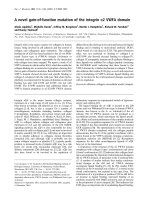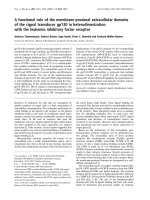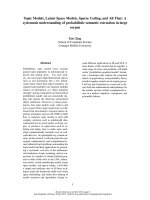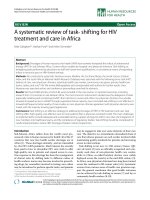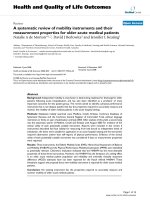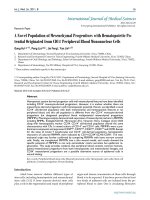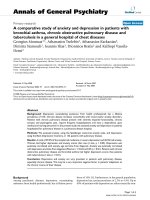Báo cáo y học: "A systematic review of the impact of sedation practice in the ICU on resource use, costs and patient safety" pptx
Bạn đang xem bản rút gọn của tài liệu. Xem và tải ngay bản đầy đủ của tài liệu tại đây (724.95 KB, 11 trang )
Jackson et al. Critical Care 2010, 14:R59
/>Open Access
RESEARCH
BioMed Central
© 2010 Jackson et al.; licensee BioMed Central Ltd. This is an open access article distributed under the terms of the Creative Commons
Attribution License ( which permits unrestricted use, distribution, and reproduction in
any medium, provided the original work is properly cited.
Research
A systematic review of the impact of sedation
practice in the ICU on resource use, costs and
patient safety
Daniel L Jackson*
1
, Clare W Proudfoot
2
, Kimberley F Cann
2
and Tim Walsh
3
Abstract
Introduction: Patients in intensive care units (ICUs) often receive sedation for prolonged periods. In order to better
understand the impact of sub-optimal sedation practice on outcomes, we performed a systematic review, including
observational studies and controlled trials which were conducted in sedated patients in the ICU and which compared
the impact of changes in or different protocols for sedation management on economic and patient safety outcomes.
Methods: We searched Medline, Embase and CINAHL online literature databases from 1988 to 15
th
May 2008 and hand
searched conferences. English-language studies set in the ICU, in sedated adult humans on mechanical ventilation,
which reported the impact of sedation practice on cost and resource use and patient safety outcomes, were included.
All abstracts were reviewed twice by two independent reviewers, with all conflicts resolved by a third reviewer, to
check that they met the review inclusion criteria. Full-text papers of all included studies were retrieved and again
reviewed twice against inclusion criteria. Data were doubly extracted from studies. Study aims, design, population, and
outcomes including duration of mechanical ventilation, length of stay in ICU and hospital, costs and rates of mortality
and adverse events were extracted. Due to heterogeneity between study designs and outcomes reported, no
quantitative data synthesis such as meta-analysis was possible.
Results: Included studies varied in design, patient population and aim, with the majority being before-after studies.
Overall, studies showed that improvements in sedation practice, such as the introduction of guidelines and protocols,
or daily interruption of sedation, were associated with improvements in outcomes including ICU and hospital length of
stay, duration of mechanical ventilation, and costs. Mortality and the incidence of nosocomial infections were also
reduced.
Conclusions: Systematic interventions to improve sedation practice and maintain patients at an optimal sedation level
in the ICU may improve patient outcomes and optimize resource usage.
Introduction
The majority of mechanically ventilated patients within
the ICU receive sedative drugs to decrease anxiety,
ensure comfort and facilitate treatments. The optimal
sedation level varies according to the medical condition
of individual patients and their treatment needs. Typi-
cally, sedation level is measured by nurses or physicians
according to simple scales, such as the Ramsay scale or
Richmond agitation sedation scale (RASS), in order to
titrate sedative drugs appropriately.
The extent to which sub-optimal sedation is a problem
in practice within ICUs is unclear, both in terms of how
frequently this occurs and its impact on outcomes. Opti-
mum sedation is dependent on factors such as the type of
patient, co-morbidities, illness severity and treatments
required. Therefore, the clinical outcome of interest may
influence the definition of optimum sedation. For exam-
ple, optimum sedation for a short-term outcome, such as
synchronisation with the ventilator, may not be identical
to longer-term outcomes, such as ventilator-associated
pneumonia, ICU length of stay or psychological sequelae
of critical illness.
* Correspondence:
1
GE Healthcare, Pollards Wood, Nightingales Lane, Chalfont St. Giles, Bucks,
HP8 4SP, UK
Full list of author information is available at the end of the article
Jackson et al. Critical Care 2010, 14:R59
/>Page 2 of 11
Sub-optimal sedation practice may affect both clinical
and economic outcomes (such as patient length of stay).
We sought to investigate the impact of sedation practice
on both patient safety and economic outcomes through a
systematic review of the publicly available literature. We
included all relevant study designs (observational studies
and controlled trials) that were conducted in sedated
patients in the ICU and compared the impact of changes
in or different protocols for sedation management on
economic and patient safety outcomes.
Materials and methods
Searching
Medline, Embase and CINAHL databases were searched
from January 1988 to 15 May 2008 using terms for seda-
tion, ICU, sub-optimal sedation and sedation quality
management. The standard Scottish Intercollegiate Guid-
ance Network (SIGN) filters for randomised controlled
trials (RCTs), economic studies and observational studies
[1] were combined to capture all study designs relevant to
the study question. The search strategy for Medline is
provided as an example [see Additional file 1]. Confer-
ence proceedings from 2005 to 2008 were hand-searched
for relevant studies. All results were uploaded into a
bespoke internet SQL-based database.
Selection criteria
Inclusion of studies was according to predetermined cri-
teria. Studies had to have a population of adult patients,
sedated and on mechanical ventilation within the ICU,
and had to report the effect of sedation practice or quality
on patient safety or economic outcomes. Studies that
reported incidence rates of sub-optimal sedation were
also included (data not shown). Short-term studies (only
including patients sedated less than 24 hours) were
excluded.
Only English-language studies were included. All
abstracts were reviewed twice by independent reviewers,
with all conflicts resolved by a third reviewer (either by
agreement with one of the reviewers or by discussion in
the case of disagreement between all three reviewers), to
check that they met the review inclusion criteria. Full-
text papers of all included studies were retrieved and
reviewed against inclusion criteria. The data from
included studies were then extracted, summarised and
analysed.
Data extraction
Data were extracted by two reviewers, with any differ-
ences reconciled by a third reviewer (either by agreement
with one of the reviewers or by discussion in the case of
disagreement between all three reviewers).
The following data were extracted if reported: country;
sponsor; study design; patient population; study aim;
study setting; number of patients in the study; details of
comparisons made - such as between different treatment
arms, or between different sedation monitoring systems;
acute physiology and chronic health evaluation
(APACHE) II or simplified acute physiology score (SAPS)
II score; duration of mechanical ventilation; length of stay
in the ICU; length of stay in hospital; time from end of
sedation to extubation; duration of sedation; total/mean
sedative drug dose; rate of unintended extubations; rate
of re-intubations; rate of procedures to investigate
reduced consciousness level; sedative costs; total costs
(ICU and hospital); mortality rate; incidence of nosoco-
mial pneumonia; and incidence of delirium.
Quantitative data synthesis
Due to the wide range of included study types, no studies
were suitable for quantitative data synthesis. This was
anticipated in advance and confirmed on evaluation of
the studies. This was due to heterogeneity in study design
(before-after versus non-randomised comparative studies
versus RCTs), outcome definition, intervention (type of
sedation protocol or intervention applied) and patient
population.
Results
Systematic review study flow
The flow of studies through the systematic review is doc-
umented in the Quality of Reporting of Meta-Analyses
(QUOROM) diagram in Figure 1.
Seventy five primary studies met the inclusion criteria,
with seven secondary publications. Twenty one studies
did not provide any data - either they did not contain data
on the outcomes abstracted in this review or they did not
Figure 1 The QUOROM diagram illustrates the flow of studies
through the systematic review. QUOROM, Quality of Reporting of
Meta-Analyses.
2967 citatio ns
from literature
databases
1964 citatio ns
excluded at 1
st
pass
10 citations
fro m
conferences
88 citations
excluded at
2
nd
pass
2124 citatio ns
after eliminating
duplicates
160 citations
ordered for full-
text review
82 citations
included
23 studies reported the
impact of sedatio n practice
on outcomes; 4 secondary
publications
31 studies reported
incidence of inappropriate
sedation only; 3 secondary
publications
21 studies did not report
any outcomes of interest
Jackson et al. Critical Care 2010, 14:R59
/>Page 3 of 11
provide this data in quantitative form. Twenty three stud-
ies reported data on the impact of sedation practice on
outcomes and are reported in this review. The remainder
reported the incidence of sub-optimal sedation and these
data are reported elsewhere. Of the excluded studies, 8
were reviews, 10 were in a non-English language, not all
patients were sedated in 10, 11 studies were not set in the
ICU, patients were not mechanically ventilated in 21 and
28 studies did not report outcomes of interest.
Summary of included studies
Nineteen studies investigated the effect of introducing a
sedation management protocol or guideline on patient
safety or economic outcomes. Of these studies, 15 were
observational in design (typically before-after studies)
and 4 were RCTs. Patient numbers ranged from 40 [2] to
1105 [3]. The predominance of relatively small, before-
after studies highlights the limited quality of the evidence
base.
The sedation protocols used varied, but generally
included guidance on frequency and method of assess-
ment of sedation adequacy, setting target sedation levels
and/or choice of sedative drugs. Three studies specifically
addressed the effect of sedation holds on outcomes [4-6].
In addition to the 19 protocol studies, an RCT of the
bispectral index (BIS) monitor [7], and an RCT of inter-
mittent lorazepam compared with continuous propofol
[8] were included.
Impact of sedation practice on duration of mechanical
ventilation
Interventions to improve sedation practice were associ-
ated with a significant reduction in duration of mechani-
cal ventilation in most studies. Sixteen studies examined
the introduction of a sedation protocol on the duration of
mechanical ventilation. Most studies used a before-after
design [3,5,9-21], although one RCT of sedation holds
was included [4]. All studies but one [17] observed a
reduction in the average duration of mechanical ventila-
tion in the protocol group, which was reported as statisti-
cally significant in eight studies [Table S1 in Additional
file 1]. Absolute reductions in duration of ventilation var-
ied due to differences between studies in average ventila-
tion duration, presumably due to variations in case-mix.
Reductions calculated as a percentage of control group
value ranged from 10% [10] to 70% [5].
Two studies specifically investigated sedation holds:
one RCT [22] and one observational study [5]. Sedation
holds significantly reduced the duration of ventilation, by
1.5 times in the RCT, and by more than three times in the
observational study. A second RCT of sedation holds
reported the proportion of ventilator-free days over the
28-day study period was significantly higher in the seda-
tion holds arm (11.6 versus 14.7) [6].
An additional RCT compared monitoring of sedation
using the BIS monitor with standard sedation manage-
ment [7]; this study reported that there was no difference
in mean duration of mechanical ventilation between
groups.
Impact of sedation practice on weaning time
Four before-after studies [9,12,15,17,20] reported wean-
ing time following protocol introduction (as a separate
outcome from duration of mechanical ventilation). There
was a significant reduction in weaning duration in two
studies [12,20].
Impact of sedation practice on length of stay in ICU
Improved sedation practice was associated with a
reduced length of stay in the ICU. Sixteen studies
reported the impact of a sedation protocol on length of
stay in the ICU [Table S1 in Additional file 1]. There were
two RCTs of sedation holds [4,6]; the remainder were
observational studies (typically before-after design)
[3,5,9-15,17-20,23]. All studies but one [17] found a pro-
tocol reduced length of stay; this was statistically signifi-
cant in eight studies. Reductions as a percentage of
control values varied from between 11% [11] to 64% [5].
Three studies specifically examined sedation holds and
all found a significant reduction in length of ICU stay
with sedation holds (of between 35% to 64%) [4-6].
Similar to ventilation duration, the RCT comparing the
BIS monitor with standard sedation management [7]
found no significant difference in median ICU stay
between groups.
Impact of sedation practice on length of stay in hospital
Improved sedation practice was associated with a reduc-
tion in hospital stay. Nine studies reported the impact of
introducing a sedation protocol on length of patient stay
in hospital [Table S1 in Additional file 1] [3-6,10,12,18-
20]. All found a reduction in length of stay in the protocol
group, which was significant in six studies
[3,5,6,12,18,20]. Six studies examined the introduction of
a general protocol for sedation improvement [3,10,12,18-
20], while three studies compared a protocol of daily
sedation holds with continuous sedation [4-6]; both types
of comparisons found significant reductions in length of
stay.
Impact of sedation practice on sedation duration, sedative
use and sedative costs
Six studies reported the impact of sedation protocols on
the mean duration of sedation. Three indicated a reduc-
tion in duration of sedation with protocols: Chanques
and colleagues [13] and De Jonghe and colleagues [14]
reported a significant reduction after introduction of a
protocol, while a third study reported a significant reduc-
tion in patients where guidelines were followed compared
Jackson et al. Critical Care 2010, 14:R59
/>Page 4 of 11
with those where guidelines were not followed [9], with
reductions ranging from 39% [9] to 50% [14]. Three stud-
ies reported no change in duration of sedation with an
intervention. These were an RCT of controlled versus
empirical sedation, and two before-after studies of seda-
tion protocols [2,17,20].
Five studies reported the impact of sedation protocols
on sedative dosage. Quenot and colleagues [20] reported
a significant decrease in daily drug dose for midazolam
and propofol with protocol, and De Jonghe and col-
leagues [14] reported a similar finding for midazolam, but
not fentanyl. An RCT reported a significant reduction in
sedative drug dose with sedation holds in patients receiv-
ing midazolam [4] and two other studies found no signifi-
cant change [10,18].
Seven studies reported the impact of sedation protocols
on the costs of sedative agents used; all found a reduction
in the costs of sedative agents with protocolised sedation,
which was reported as significant in four studies
[2,9,17,19], with values ranging from 22% to 94% of the
cost for non-protocol managed sedation [Table S1 in
Additional file 1].
Impact of sedation practice on patient safety outcomes
Mortality
Thirteen studies reported the impact of sedation proto-
cols on mortality [3-6,10-14,16,18-20], of which three
specifically investigated sedation holds [4-6] (Table 1).
Two studies of sedation holds were RCTs [4,6]; all
remaining studies were before-after comparisons. Typi-
cally studies reported mortality rate for the period when
patients were in the ICU, or in hospital, although Girard
and colleagues reported 28-day and 1-year mortality rates
[6]. Two sedation protocol studies showed a significant
decrease in mortality following the introduction of a pro-
tocol [3,16], whereas the remainder showed no statisti-
cally significant change.
One of the sedation hold RCTs showed no significant
effect on 28-day mortality, but a significant reduction in
mortality after one year in the group where spontaneous
breathing trials (SBTs) were paired with daily interrup-
tion of sedation in comparison with the control group [6].
The authors offered no explanation for this apparent late
survival benefit. The other RCT and the before-after
study comparing standard care with daily sedation holds
reported non-significant decreases in mortality with daily
sedation holds (47% versus 36% [4] and 34% versus 30%
[5]). None of these studies were powered to detect mor-
tality differences a priori.
One further study described mortality in relation to the
introduction of intermittent bolus sedation compared
with continuous sedation (both with daily sedation holds)
and found no effect on mortality [8].
ICU-acquired pneumonia
Five studies reported the impact of sedation protocols on
nosocomial pneumonia [4,10,13,14,20] (Table 1). Four
were before-after studies [10,13,14,20]. Two showed sig-
nificant reductions in the percentage of patients develop-
ing pneumonia [10,20]; a third study showed a significant
impact on events per 1000 ventilation days but not on the
proportion of patients with pneumonia [13]. The remain-
ing study showed a non-significant increase in absolute
incidence [4]. One RCT of daily sedation holds showed a
reduction in pneumonia from 8% to 3% in the interven-
tion group, which was not statistically significant. None
of the studies were powered to detect changes a priori.
Extubation
Nine studies reported rates of self-extubation or acciden-
tal extubation [3,6,8,11,13,18,20,24] (Table 1). The only
study which showed a significant difference in rates was
the RCT by Girard and colleagues, which showed an
excess of accidental extubations in the group randomised
to daily sedation breaks and spontaneous breathing trials
[6]. However, there was no difference in re-intubations,
suggesting that many patients were ready for extubation,
but did so unintentionally.
Reintubations
Five studies reported rates of re-intubations [5,6,8,12,18];
the only significant reduction was reported by the seda-
tion holds study by Kollef and colleagues [5].
Spontaneous breathing trials
Two studies specifically described responses to SBTs in
relation to sedation practice. In an RCT comparing inter-
mittent lorazepam plus daily sedation break with propo-
fol plus daily sedation break, the rapid shallow breathing
index was significantly higher in patients randomised to
lorazepam, suggesting that sedative drug may influence
performance during SBTs [8]. In the RCT by Girard and
colleagues, patients in the group randomised to daily
sedation hold plus SBT had significantly higher RASS
scores at the time of their first successful SBT than those
randomised to SBTs and standard sedation practice [6].
These data suggest that both choice of sedative drug and
sedation regimen potentially influence performance dur-
ing SBTs.
Delirium
Surprisingly few studies evaluated the impact of sedation
protocols on incidence of delirium. In the RCT compar-
ing SBTs alone with SBTs plus daily sedation hold there
was no difference in the incidence of delirium [6]. An
RCT comparing sedation with dexmedetomidine with
lorazepam found a significant reduction in prevalence or
duration of delirium or coma, but not delirium alone,
with dexmedetomidine [24].
Jackson et al. Critical Care 2010, 14:R59
/>Page 5 of 11
Table 1: Impact of sedation practice on patient safety outcomes
Study Study type Sample
size
Comparison
Percentage mortality
rate, timepoint for
measurement and P
value for comparison
Incidence of
nosocomial
pneumonia
(%)
Accidental
extubation
rate (%)
Re-intubation
rate
Marshall
and
colleagues
2008 [18]
Introduction
of protocol
(before-after
study)
156 Before Hospital mortality: 18% 10% (self-
extubation)
11.5%
After active
pharmacist
intervention
Hospital mortality: 15%
P = 0.83
4% (self-
extubation)
P = 0.2
10.3%
P = 0.8
Quenot and
colleagues
2007 [20]
Introduction
of protocol
(before-after
study)
423 Before ICU mortality: 39%
Hospital mortality: 45%
15%
(ventilator
associated
pneumonia)
7 (unscheduled
self-
extubation)
After introduction
of nurse-led
sedation protocol
ICU mortality: 32%
P = 0.19
Hospital mortality: 38% P
= 0.22
6% (ventilator
associated
pneumonia)
P = 0.005
11
(unscheduled
self-
extubation)
P = 0.09
Arabi and
colleagues
2007 [10]
Introduction
of protocol
(before-after
study)
207 Before education
no protocol
ICU mortality: 20%
Hospital mortality: 24%
28%
Before education
protocol
ICU mortality: 18%
Hospital mortality: 24%
29%
After education
no protocol
ICU mortality: 23%
Hospital mortality: 36%
11%
After education -
protocol
ICU mortality: 13% P =
0.64 for all comparisons
Hospital mortality: 23%
P = 0.35 for all
comparisons
11%
P = 0.02
Chanques
and
colleagues
2006 [13]
Introduction
of protocol
(before-after
study)
230 Before ICU mortality: 12% 14% 4% (self-
extubation)
After monitoring
of agitation
ICU mortality: 15%
P = 0.76
9%
P = 0.31; P =
0.03 for
events/1000
ventilation
days
2% (self-
extubation)
P = 0.65
Jackson et al. Critical Care 2010, 14:R59
/>Page 6 of 11
Burns and
colleagues
2003 [3]
Introduction
of protocol
(before-after
study)
1105 Before 38% (timepoint unclear) 10%
After introduction
of outcomes
management
protocol
31%
P = 0.02 (timepoint
unclear)
7%
Mascia and
colleagues
2000 [19]
Introduction
of protocol
(before-after
study)
156 Before 16.7% (timepoint
unclear)
After introduction
of protocol
17.6%
P = 0.89 (timepoint
unclear)
Jakob and
colleagues
2007 [16]
Introduction
of protocol
(before-after
study)
300 After
implementation of
intervention 1
(change in ICU
organisation)
ICU mortality: 19%
After
implementation of
intervention 2
(introduction of
protocols for
weaning)
ICU mortality: 8%
After
implementation of
intervention 1
(change in ICU
organisation)
ICU mortality: 7%
P = 0.02
De Jonghe
and
colleagues
2005 [14]
Introduction
of protocol
(before-after
study)
102 Before 8%
After introduction
of protocol
20.4%
P = 0.1
Brattebo
and
colleagues
2002; 2004
[11,28]
Introduction
of protocol
(before-after
study)
285 Before ICU mortality: 27% 0
After introduction
of protocol
ICU mortality: 22% (not
significant)
0
Table 1: Impact of sedation practice on patient safety outcomes (Continued)
Jackson et al. Critical Care 2010, 14:R59
/>Page 7 of 11
Brook and
colleagues
1999 [12]
Introduction
of protocol
(before-after
study)
321 Before Hospital mortality: 36% 9%
After introduction
of protocol
Hospital mortality: 30% 13% P = 0.213
Kress and
colleagues
2000; 2001;
Schweickert
and
colleagues
2004
[4,22,29]
RCT of daily
interruption of
sedation
128 Continuous
sedation
Hospital mortality: 47% 8% (ventilator-
associated
pneumonia)
Sedation
interrupted daily
Hospital mortality: 36%
P = 0.25
3% (ventilator-
associated
pneumonia)
Girard and
colleagues
2008 [6]
RCT of
spontaneous
breathing
trials with and
without daily
interruption of
sedation
335 Continuous
sedation +
spontaneous
breathing trial
28-day mortality: 35%
1-year mortality: 58%
10% self-
extubations
3% required re-
intubation
14%
Sedation
interrupted daily +
spontaneous
breathing trial
28-day mortality: 28%
P = 0.21
1-year mortality: 44%
P = 0.01
4% self-
extubation
P = 0.03
2% required
re-intubation
P = 0.47
13%
P = 0.73
Kollef and
colleagues
1998 [5]
Continuous
sedation vs
intermittent
sedation
242 Continuous
sedation
Hospital mortality: 34% 15%
Sedation
interrupted daily
Hospital mortality: 30%
P = 0.58
5% P = 0.005
Carson and
colleagues
2006 [8]
RCT of
intermittent
lorazepam vs.
continuous
propofol
132 Lorazepam Hospital mortality: 38% 2% self-
extubations
16%
reintubations
Propofol Hospital mortality: 37% 5% self-
extubations
P = 0.62
12%
reintubations
P = 0.59
Table 1: Impact of sedation practice on patient safety outcomes (Continued)
Jackson et al. Critical Care 2010, 14:R59
/>Page 8 of 11
Pandharipa
nde and
colleagues
2007a, b;
2006
[24,30,31]
RCT of
dexmedetomi
dine vs
lorazepam
(RASS
individualised
to each
patient)
103 Dexmedetomi-
dine
28-day mortality: 17% 8%
Lorazepam 28-day mortality: 27%
P = 0.18
4% P = 0.41
RASS, Richmond agitation sedation scale; RCT, randomised controlled trial.
Table 1: Impact of sedation practice on patient safety outcomes (Continued)
Procedures to investigate decreased consciousness
Only one study - the Kress RCT of sedation holds - spe-
cifically reported the incidence of procedures to investi-
gate reduced consciousness level, and reported a
significant reduction in diagnostic tests to assess changes
in mental status (6 computed tomography (CT) scans
versus 13 CT scans, 2 magnetic resonance imaging scans,
and 1 lumbar puncture, P = 0.02) [4]. A second RCT of
sedation holds also reported that the incidence of
decreased consciousness such as coma was reduced by
sedation holds, with a lower average duration of coma
observed with sedation holds (P = 0.002) [6].
Discussion
Our systematic review identified studies comparing the
impact of different sedation practices on patient safety
and economic outcomes. The included studies varied in
study design, patient population, intervention, setting
and time of study, preventing quantitative synthesis. Dif-
ferences in individual study definitions of outcomes was
also a major limitation that affected the potential for
drawing firm conclusions from the data; however, it
should be noted that comparisons made within studies
(for example before-after or between groups) are still
valid due to the fact that outcome definition can be
assumed to be relatively consistent within studies. Never-
theless, the data strongly supported an association
between specific interventions designed to optimise
sedation and reduce duration of ICU stay and ventilation
times. There were also suggestions of reductions in ICU-
acquired pneumonia and short-term mortality in many
studies.
Overall study quality was poor. The majority of studies
were of before-after design and only four RCTs were
identified. In addition, most studies enrolled relatively
small numbers of patients and were not powered a priori
for important patient-centred outcomes. The RCTs were
relatively small-scale, with fewer than 500 patients
included.
Before-after studies are less reliable forms of evidence
than concurrent or randomised comparisons. They are
subject to bias as other factors may change over time,
which can affect outcomes. This is particularly important
in critical care studies, where facilities, staffing and
patient case-mix frequently change over time. One
approach to correct for potential confounding is to adjust
statistically, but this was not done in most studies. There
is also a high risk of reporting bias, because studies where
a protocol was introduced but had no beneficial effects
on outcomes are less likely to be submitted or accepted
for publication.
Baseline sedation practice will influence the plausibility
of an intervention to improve outcomes. There was varia-
tion in patient characteristics and in baseline outcome
values between studies, suggesting variation in sedation
practice. However, limited details on baseline sedation
practice, such as details of staffing levels and training,
were provided, making it difficult to assess the impact of
baseline practice on results.
A further possibility for bias is that it is not possible and
is impractical to blind staff in protocol studies. This could
result in a control group improvement associated with
the study (the Hawthorne effect), but also potentially an
artificial decrease in sedation quality in the control group
compared with standard care. These factors emphasise
the importance of clearly defining and describing 'stan-
dard care' in these studies.
It is possible that relevant studies may be missed. This
review was confined to English-language publications,
and therefore is biased towards the US, Europe and UK in
focus. We also limited conference searching, which could
have missed some of the relevant grey literature.
Despite these limitations, there was a consistent finding
in both RCTs and before-after studies that interventions
designed to optimise sedation practice improved out-
comes. Systematic interventions reduced the duration of
mechanical ventilation, length of ICU stay and the length
of hospital stay. Fewer studies reported outcomes of total
Jackson et al. Critical Care 2010, 14:R59
/>Page 9 of 11
sedation duration, sedative dose and sedative cost. How-
ever, the available evidence indicated that these outcomes
were also improved by protocol-directed sedation. The
consistent numerical trend towards improvements across
all ventilation and patient stay outcomes in most studies
suggest that a systematic management approach is clini-
cally important.
The available data also support an association between
improvements in sedation practice and improved patient
safety. Protocol-directed sedation tended to reduce mor-
tality; although this was only statistically significant in 2
of 13 studies, the numerical trend was for a decrease and
the lack of significance could be due to underpowered
studies. Given the association between excessive sedation
and adverse outcomes that are linked to patient mortality,
such as nosocomial infection and delirium, it is biologi-
cally plausible that improving sedation practice could
improve mortality.
Other important patient-safety outcomes were also
reported by some studies. The most relevant of these was
incidence of nosocomial pneumonia, which is associated
with prolongation of ICU stay, poorer patient outcomes
and increased costs. It is also a key quality indicator [25],
and is linked to reimbursement in some healthcare set-
tings. Despite the fact that most studies were not pow-
ered to detect differences in pneumonia incidence, there
was a consistent suggestion of reductions in incidence
with sedation improvements.
Less information was available for other safety out-
comes. Increased rates of accidental extubation were not
reported in most studies, and in the RCT that did report
an increase in the intervention group the data suggested
that this may have benefitted patients because re-intuba-
tion rates were similar to the control group [6]. Few stud-
ies systematically reported delirium. Delirium has been
associated with sedation use, especially benzodiazepines,
and is also associated independently with adverse out-
comes in ICU populations [26]. One RCT found similar
rates of delirium between the control group and a daily
sedation hold group, where sedative drugs used were
similar in both arms [6]. In contrast, a comparison of dex-
medetomidine with lorazepam suggested decreased rates
of delirium and coma with use of dexmedetomidine [24].
Therefore, choice of sedative agent may remain impor-
tant even after controlling for other aspects of sedation
practice. A detailed description and comparison of differ-
ent sedative agents was not the aim of this review. In
addition to these above-mentioned outcomes, a number
of other important outcomes outside the scope of this
review may be impacted by sedation quality, such as pain,
anxiety or occurrence of post-traumatic stress disorder.
There was significant variation between studies in the
approach taken to improving sedation. The management
of sedation is complex and it is not possible to conclude
from this review which component of the protocols was
most associated with improved patient outcomes. The
most recently published RCTs, which were the highest
quality studies [4,6], indicate a strong association
between daily cessation of sedation and improved out-
comes. This finding supports the routine inclusion of this
procedure in standard care, as is recommended in most
recent guidelines and quality improvement initiatives
[27]. It is also of note that few studies to date have
addressed the question of sedation management in
severely ill cases in the ICU, in whom sedation protocols
are more difficult to apply and further work in this area is
undoubtedly warranted.
Several technologies have been developed to measure
consciousness level. These include the BIS and Entropy
monitors. Although extensive literature is available on the
association between these parameters and clinical seda-
tion state, we only found one trial meeting our inclusion
criteria. This was a small RCT using BIS, which found no
benefit [7]. Therefore, additional studies are required to
evaluate the impact of such technologies on patient-cen-
tred and economic outcomes. The association between
practice-based interventions and improvements in clini-
cal outcomes apparent from this systematic review indi-
cate a need for formal outcome-based evaluation of
health technologies in this area.
Conclusions
Management of sedation during critical illness has been a
focus of increased interest, particularly over the past
decade. The overall quality of studies in this area is low.
Nevertheless, this review indicates a strong association
between systematic approaches to improving sedation
and reduced duration of mechanical ventilation and
length of ICU stay. The highest quality evidence suggests
inclusion of daily sedation breaks is beneficial. Available
evidence does not suggest an increase in adverse events
with interventions that generally decrease sedation dose
and duration, and risk of ICU-acquired pneumonia is
probably decreased by such strategies. The quality and
nature of standard care, and patient case-mix, are likely to
be important determinants of the impact of changes
within individual ICUs. Sedation practice is likely to
strongly influence health care costs and improving seda-
tion practice may not only benefit patients but also
reduce such costs.
Key messages
• Management of sedation during critical illness has
been a focus of increased interest, particularly over
the past decade.
• There is a strong association between systematic
approaches to improving sedation and reduced dura-
tion of mechanical ventilation and length of ICU stay.
Jackson et al. Critical Care 2010, 14:R59
/>Page 10 of 11
• The highest quality evidence suggests inclusion of
daily sedation breaks is beneficial.
• Sedation practice is likely to strongly influence
health care costs and improving sedation practice
may not only benefit patients but also reduce such
costs.
Authors' information
Timothy Walsh is a Professor of Anaesthetics and Critical
Care at Edinburgh University. Daniel Jackson is Head of
Health Economics, EMEA at GE Healthcare. Clare
Proudfoot is a Consultant at Heron Evidence Develop-
ment Ltd, a health outcomes research consultancy. Kim-
berley Cann is a Health Outcomes Analyst at Heron
Evidence Development Ltd.
Additional material
Abbreviations
APACHE: acute physiology and chronic health evaluation; BIS: Bispectral Index
Monitor; CT: computed tomography; QUOROM: Quality of Reporting of Meta-
Analyses; RASS: Richmond agitation sedation scale; RCT: randomised con-
trolled trials; SBT: spontaneous breathing trial; SIGN: Scottish Intercollegiate
Guidance Network. SAPS: simplified acute physiology score.
Competing interests
CP and KC are employed by Heron Evidence Development, which was com-
missioned by GE Healthcare to undertake this research. DJ is employed by GE
Healthcare. GE is actively involved in the critical care area.
Authors' contributions
DJ conceived the study and helped with manuscript revisions. CP designed
and performed searches, extracted data and wrote the manuscript draft. KC
researched and wrote the treatment guidelines section and assisted with data
extraction for the main systematic review. TW provided expert clinical input
and worked on manuscript revisions.
Acknowledgements
This study was funded by GE Healthcare. The work was performed at Heron
Evidence Development Ltd, UK.
Author Details
1
GE Healthcare, Pollards Wood, Nightingales Lane, Chalfont St. Giles, Bucks, HP8
4SP, UK,
2
Heron Evidence Development Ltd, Building 210A, Butterfield
Technology and Business Park, Luton, LU2 8DL, UK and
3
Royal Infirmary of
Edinburgh, Edinburgh, EH16 2SA, UK
References
1. SIGN. Methodology - search filters [Report] [ />methodology/filters.html]
2. Costa J, Cabre L, Molina R, Carrasco G: Cost of ICU sedation: comparison
of empirical and controlled sedation methods. Clin Intensive Care 1994,
5:17-21.
3. Burns SM, Earven S, Fisher C, Lewis R, Merrell P, Schubart JR, Truwit JD,
Bleck TP, University of Virginia Long Term Mechanical Ventilation Team:
Implementation of an institutional program to improve clinical and
financial outcomes of mechanically ventilated patients: one-year
outcomes and lessons learned[see comment]. Crit Care Med 2003,
31:2752-2763.
4. Kress JP, Pohlman AS, Hall JB: Effects of sedative interruption in critically
ill, mechanically ventilated patients receiving midazolam or propofol.
JCOM 2001, 8:33-39.
5. Kollef MH, Levy NT, Ahrens TS, Schaiff R, Prentice D, Sherman G: The use of
continuous IV sedation is associated with prolongation of mechanical
ventilation. Chest 1998, 114:541-548.
6. Girard TD, Kress JP, Fuchs BD, Thomason JW, Schweickert WD, Pun BT,
Taichman DB, Dunn JG, Pohlman AS, Kinniry PA, Jackson JC, Canonico AE,
Light RW, Shintani AK, Thompson JL, Gordon SM, Hall JB, Dittus RS,
Bernard GR, Ely EW: Efficacy and safety of a paired sedation and
ventilator weaning protocol for mechanically ventilated patients in
intensive care (Awakening and Breathing Controlled trial): a
randomised controlled trial[see comment]. Lancet 2008, 371:126-134.
7. Weatherburn C, Endacott R, Tynan P, Bailey M: The impact of bispectral
index monitoring on sedation administration in mechanically
ventilated patients. Anaesth Intensive Care 2007, 35:204-208.
8. Carson SS, Kress JP, Rodgers JE, Vinayak A, Campbell-Bright S, Levitt J,
Bourdet S, Ivanova A, Henderson AG, Pohlman A, Chang L, Rich PB, Hall J:
A randomized trial of intermittent lorazepam versus propofol with
daily interruption in mechanically ventilated patients[see comment].
Crit Care Med 2006, 34:1326-1332.
9. Anon: Sedation monitoring service reduces costs, cuts duration of
ventilation and ICU stay. Formulary 1999, 34:710-711.
10. Arabi Y, Haddad S, Hawes R, Moore T, Pillay M, Naidu B, Issa A, Yeni B, Grant
C, Alshimemeri A: Changing sedation practices in the intensive care
unit protocol implementation, multifaceted multidisciplinary
approach and teamwork. Middle East J Anesthesiol 2007, 19:429-447.
11. Brattebo G, Hofoss D, Flaatten H, Muri AK, Gjerde S, Plsek PE:
Effect of a
scoring system and protocol for sedation on duration of patients' need
for ventilator support in a surgical intensive care unit. QUAL SAF HEALTH
CARE 2004, 13:203-205.
12. Brook AD, Ahrens TS, Schaiff R, Prentice D, Sherman G, Shannon W, Kollef
MH: Effect of a nursing-implemented sedation protocol on the
duration of mechanical ventilation[see comment]. Crit Care Med 1999,
27:2609-2615.
13. Chanques G, Jaber S, Barbotte E, Violet S, Sebbane M, Perrigault PF, Mann
C, Lefrant JY, Eledjam JJ: Impact of systematic evaluation of pain and
agitation in an intensive care unit[see comment]. Crit Care Med 2006,
34:1691-1699.
14. De Jonghe B, Bastuji-Garin S, Fangio P, Lacherade JC, Jabot J, Appere-De-
Vecchi C, Rocha N, Outin H: Sedation algorithm in critically ill patients
without acute brain injury. Crit Care Med 2005, 33:120-127.
15. Devlin JW, Holbrook AM, Fuller HD: The effect of ICU sedation guidelines
and pharmacist interventions on clinical outcomes and drug cost. Ann
Pharmacother 1997, 31:689-695.
16. Jakob SM, Lubszky S, Friolet R, Rothen HU, Kolarova A, Takala J: Sedation
and weaning from mechanical ventilation: effects of process
optimization outside a clinical trial. J Crit Care 2007, 22:219-228.
17. MacLaren R, Plamondon JM, Ramsay KB, Rocker GM, Patrick WD, Hall RI: A
prospective evaluation of empiric versus protocol-based sedation and
analgesia. Pharmacotherapy 2000, 20:662-672.
18. Marshall J, Finn CA, Theodore AC: Impact of a clinical pharmacist-
enforced intensive care unit sedation protocol on duration of
mechanical ventilation and hospital stay[see comment]. Crit Care Med
2008, 36:427-433.
19. Mascia MF, Koch M, Medicis JJ: Pharmacoeconomic impact of rational
use guidelines on the provision of analgesia, sedation, and
neuromuscular blockade in critical care[see comment]. Crit Care Med
2000, 28:2300-2306.
20. Quenot JP, Ladoire S, Devoucoux F, Doise JM, Cailliod R, Cunin N, Aube H,
Blettery B, Charles PE: Effect of a nurse-implemented sedation protocol
on the incidence of ventilator-associated pneumonia[see comment].
Crit Care Med 2007, 35:2031-2036.
21. Tierney M, Snell CC, Cardinal P, Baxter A: Comparison of duration of
mechanical ventilation and cost associated with midazolam and
lorazepam infusions in critically ill patients. Can J Hosp Pharm 1996,
49:211-215.
22. Kress JP, Pohlman AS, O'Connor MF, Hall JB: Daily interruption of
sedative infusions in critically ill patients undergoing mechanical
ventilation[see comment]. N Engl J Med 2000, 342:1471-1477.
Additional file 1 Additional material - Search strategy and impact of
sedation practice on resource use. This file contains two tables showing
(1) the Medline search strategy and (2) a table of data from studies showing
the impact of sedation practice on resource use.
Received: 18 December 2009 Revised: 19 February 2010
Accepted: 9 April 2010 Published: 9 April 2010
This article is available from: 2010 Jackson et al.; licensee BioMed Central Ltd. This is an open access article distributed under the terms of the Creative Commons Attribution License ( which permits unrestricted use, distribution, and reproduction in any medium, provided the original work is properly cited.Critica l Care 2010, 14:R 59
Jackson et al. Critical Care 2010, 14:R59
/>Page 11 of 11
23. Bair N, Bobek MB, Hoffman-Hogg L, Mion LC, Slomka J, Arroliga AC:
Introduction of sedative, analgesic, and neuromuscular blocking agent
guidelines in a medical intensive care unit: physician and nurse
adherence[see comment]. Crit Care Med 2000, 28:707-713.
24. Pandharipande PP, Pun BT, Herr DL, Maze M, Girard TD, Miller RR, Shintani
AK, Thompson JL, Jackson JC, Deppen SA, Stiles RA, Dittus RS, Bernard GR,
Ely EW: Effect of sedation with dexmedetomidine vs lorazepam on
acute brain dysfunction in mechanically ventilated patients: the
MENDS randomized controlled trial[see comment]. JAMA 2007,
298:2644-2653.
25. American Thoracic Society: Guidelines for the management of adults
with hospital-acquired, ventilator-associated, and healthcare-
associated pneumonia. Am J Respir Crit Care Med 2005, 171:388-416.
26. Girard TD, Pandharipande PP, Ely EW: Delirium in the intensive care unit.
Crit Care 2008, 12 Suppl 3:S3.
27. Dellinger RP, Levy MM, Carlet JM, Bion J, Parker MM, Jaeschke R, Reinhart
K, Angus DC, Brun-Buisson C, Beale R, Calandra T, Dhainaut JF, Gerlach H,
Harvey M, Marini JJ, Marshall J, Ranieri M, Ramsay G, Sevransky J,
Thompson BT, Townsend S, Vender JS, Zimmerman JL, Vincent JL:
Surviving Sepsis Campaign: international guidelines for management
of severe sepsis and septic shock: 2008. Crit Care Med 2008, 36:296-327.
28. Brattebo G, Hofoss D, Flaatten H, Muri AK, Gjerde S, Plsek PE: Effect of a
scoring system and protocol for sedation on duration of patients' need
for ventilator support in a surgical intensive care unit. BMJ 2002,
324:1386-1389.
29. Schweickert WD, Gehlbach BK, Pohlman AS, Hall JB, Kress JP: Daily
interruption of sedative infusions and complications of critical illness
in mechanically ventilated patients[see comment]. Crit Care Med 2004,
32:1272-1276.
30. Pandharipande PP, Herr DL, Maze M, Thompson JL, Ely EW: Efficacy of
long-term sedation and delirium duration with dexmedetomidine in
critically ill patients [Abstract]. Anesthesiology 2007, 107:A1214.
31. Pandharipande PP, Frizzell J, Pun BT, Maze M, Ely EW: Randomized
controlled trial comparing dexmedetomidine with lorazepam to
reduce delirium in the ICU [Abstract]. Anesthesiology 2006, 105:A210.
doi: 10.1186/cc8956
Cite this article as: Jackson et al., A systematic review of the impact of seda-
tion practice in the ICU on resource use, costs and patient safety Critical Care
2010, 14:R59
